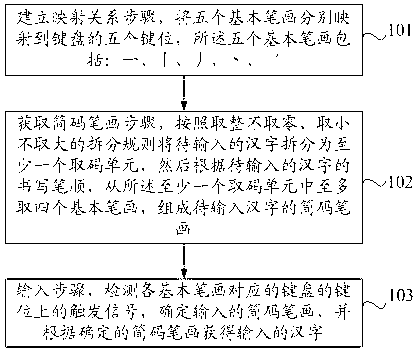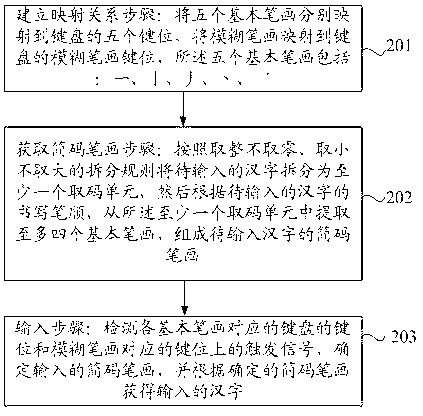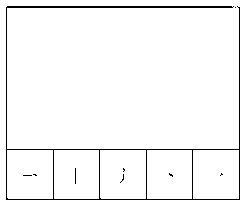Chinese character input method and keyboard realizing same
A Chinese character input and keyboard technology, applied in the information field, can solve the problems of low repetition rate, unfavorable promotion, affecting the speed of input, etc., to achieve the effect of simple code fetching rules and improved input efficiency
- Summary
- Abstract
- Description
- Claims
- Application Information
AI Technical Summary
Problems solved by technology
Method used
Image
Examples
example 1
[0057] Example 1: The Chinese character to be input is "大". According to the above splitting rules, "大" characters cannot be split into character parts and root parts, but can only be split into basic strokes, that is, "一丿丶"; "大" is split into one code The single word of the unit, according to the above code-taking rule-after the single word is split, a code-taking unit is obtained, and the number of strokes of the code-taking unit is less than 4, all the strokes of the code-taking unit are taken to form a simple code stroke, so the code is obtained The simple strokes of the code are "一丿丶"; click the keys corresponding to horizontal, apostrophe and dot on the keyboard to input Chinese characters.
[0058] In the preset single-character dictionary, the storage format of "big" is: big --- big --- one 丿丶 --- one 丿. Detect the clicked keyboard key to get the short code stroke as "一丿丶", search in the preset short code stroke and character comparison table, you can get a list of candi...
example 2
[0059] Example 2: The Chinese character to be input is "phase". According to the above splitting rules, the word "xiang" can be split into the word component "木目"; the word "xiang" is a single word that is split into two code-taking units. According to the above code-taking rule-for splitting into two For the single characters of the code unit, take the first two strokes of each code unit according to the writing stroke order to form a simple code stroke. When there is only 1 stroke in a code unit, take all the strokes in the code unit and get the code. The simple strokes of the code are "一丨丨乛"; click the corresponding horizontal, vertical, vertical and fold keys on the keyboard to input Chinese characters.
[0060] In the preset single-character dictionary, the storage form of the word "phase" is: phase --- wooden item --- one 丿,'丨 乛 one one --- one 丨 乛, where "'" is the separator . The clicked keyboard key is detected to obtain the short code strokes as "一丨丨乛", and the code l...
example 3
[0061] Example 3: The Chinese character to be input is "想". According to the above-mentioned splitting rules, the word "xiang" can be split into the word component "木目心"; the word "xiang" is a single word split into three code-taking units. According to the above code-taking rule-for splitting into three A single word of a code taking unit, according to the writing stroke order, take the first two strokes of the first code taking unit, the first stroke of the second code taking unit, and the first stroke of the third code taking unit to form a simple code stroke, when the first code taking unit When there is only 1 stroke in the first code-taking unit, take all the strokes in the first code-taking unit, and the short code strokes obtained by taking the code are "一丨丨丶"; click the corresponding horizontal, vertical, vertical, and dot keys on the keyboard to input Chinese characters .
[0062] In the single-character dictionary, the storage form of the word "xiang" is: Xiang --- Mu...
PUM
 Login to View More
Login to View More Abstract
Description
Claims
Application Information
 Login to View More
Login to View More - R&D
- Intellectual Property
- Life Sciences
- Materials
- Tech Scout
- Unparalleled Data Quality
- Higher Quality Content
- 60% Fewer Hallucinations
Browse by: Latest US Patents, China's latest patents, Technical Efficacy Thesaurus, Application Domain, Technology Topic, Popular Technical Reports.
© 2025 PatSnap. All rights reserved.Legal|Privacy policy|Modern Slavery Act Transparency Statement|Sitemap|About US| Contact US: help@patsnap.com



